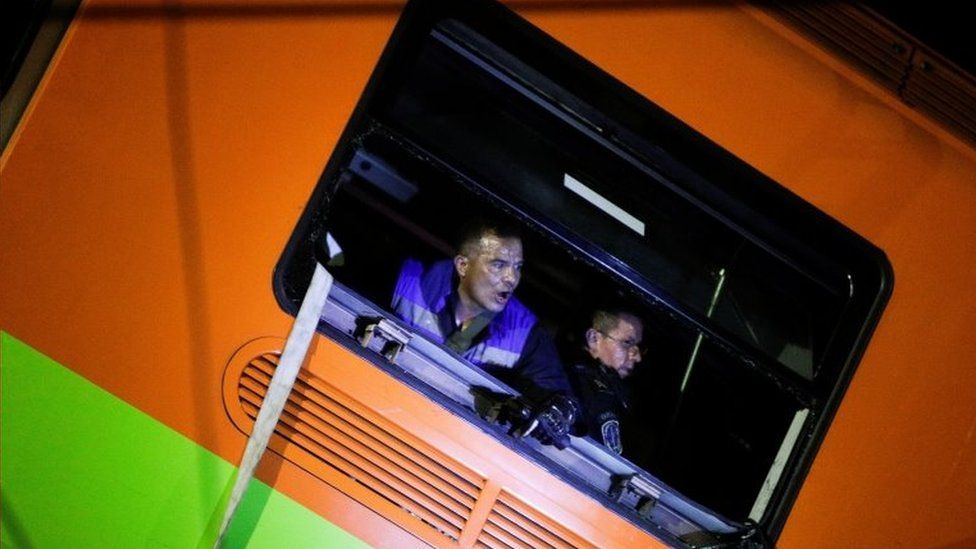Two train carriages plunged to the ground when an elevated metro line collapsed.
A metro overpass has collapsed in Mexico City as a train was travelling over it, killing at least 23 people, including children, the mayor said.
Two train carriages were seen hanging from the structure, above a busy road. At least 65 people were injured, and seven are in a serious condition.
One person trapped in a car underneath the wreckage was pulled out alive.
This is the deadliest incident in decades in the city’s metro system, one of the busiest in the world.
Local media broadcast CCTV footage showing the overpass collapsing, sending up clouds of debris. The crash happened at around 22:00 local time on Monday (03:00 GMT) near the Olivos station on the metro’s Line 12, in the south-east of the city.
Mexico City Mayor Claudia Sheinbaum said an external company would investigate the cause of the incident. Earlier, she said it appeared a girder had given way on the overpass. The line, inaugurated less than a decade ago, will remain closed while a structural survey is carried out.
Speaking at a news conference alongside the mayor, President Andrés Manuel López Obrador offered his condolences to the relatives of the victims and said that “nothing would be hidden” from the Mexican people.
Residents had reported cracks in the structure after a deadly 2017 earthquake, according to local media. Mexico’s El Universal newspaper says transport authorities made repairs following the reports.

image copyrightReuters

image copyrightReuters
A crane was sent to the scene to stabilise the carriages amid concerns they could fall onto the road, which forced officials to temporarily halt rescue efforts at night.
In chaotic scenes, anxious friends and relatives of those believed to be on the train gathered in the area. Efraín Juárez told AFP news agency that his son was in the wreckage. “My daughter-in-law called us. She was with him and she told us the structure fell down over them.”
Gisela Rioja Castro, 43, was looking for her 42-year-old husband, who always take that train after work and had not been answering his phone. She said the authorities had no information about him. “Nobody knows anything,” she told the Associated Press.

image copyrightGetty and Google Maps

A passenger, 26-year-old Mariana, told El Universal that she and other people trapped among the carriage’s twisted metal managed to escape through a window.
“We only heard a loud thunder, and everything fell apart,” she said of the moment of the incident. “There were many people standing and sitting in the carriage, and when the carriage fell, we went flying and hit our heads on its roof.”

image copyrightReuters

image copyrightReuters
One eyewitness told Mexico’s Televisa TV network: “Suddenly I saw that the structure was shaking.”
“When the dust cleared we ran… to see if we could help. There were no screams. I don’t know if they were in shock,” the witness said.


Mexico City’s metro system is one of the most used in the world, carrying tens of millions of passengers a week. In North America, only New York’s subway carries more people every day.
Yet the incident did not occur on one of the older lines, which have been through at least two major earthquakes in the past 35 years. Rather it happened on Line 12, completed as recently as October 2012.
There will be difficult questions for the mayor’s office to come about the construction of the line, including for several former mayors.
They include Mexican Foreign Minister Marcelo Ebrard, who was in office when Line 12 was unveiled and who championed the metro’s expansion. He called the accident a “terrible tragedy”.
However, those questions must wait until later. The moment now is solely about the rescue operation as Mexicans pray the number of victims does not rise any further.

Last year, one person was killed and more than 40 injured in a collision between two metro trains in Mexico City.
In 1975, two underground trains collided, killing 31 people.


Were you in the area? Did you witness what happened? Share your experiences by emailing haveyoursay@bbc.co.uk.
Please include a contact number if you are willing to speak to a BBC journalist. You can also get in touch in the following ways:
If you are reading this page and can’t see the form you will need to visit the mobile version of the BBC website to submit your question or comment or you can email us at HaveYourSay@bbc.co.uk. Please include your name, age and location with any submission.